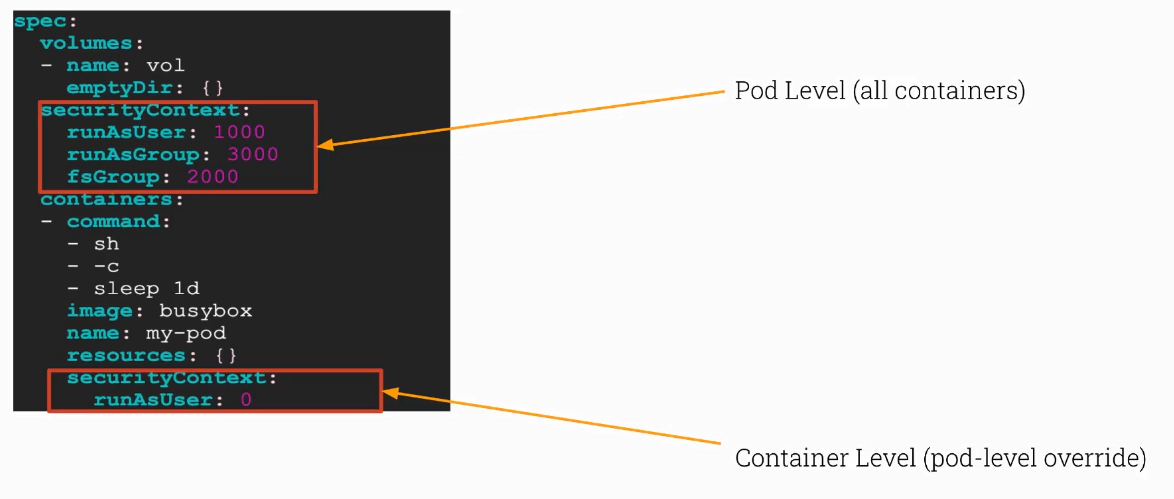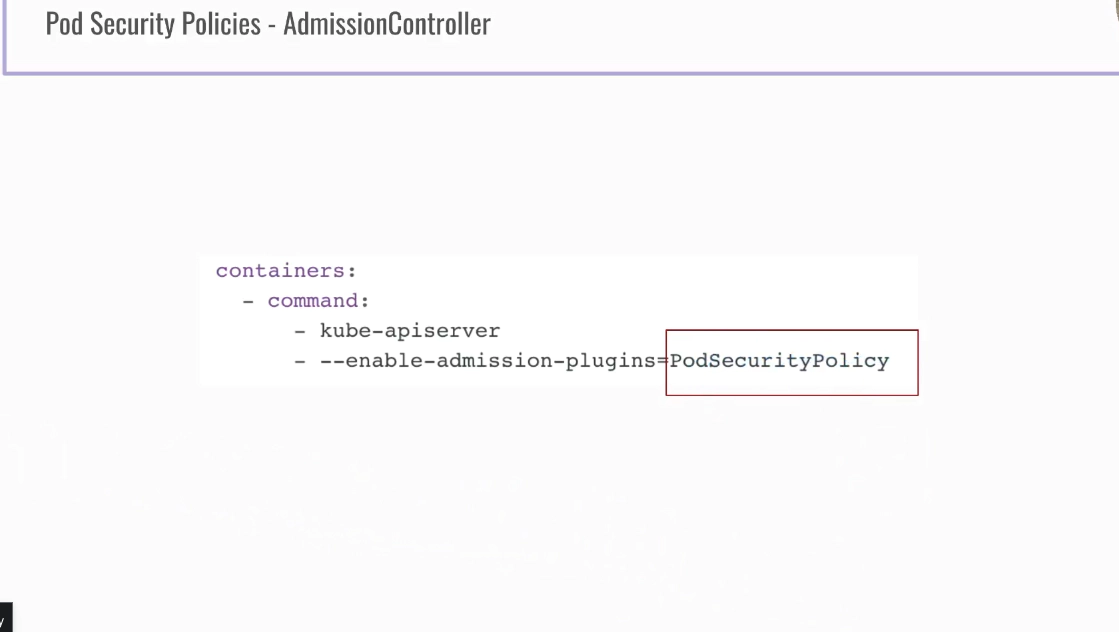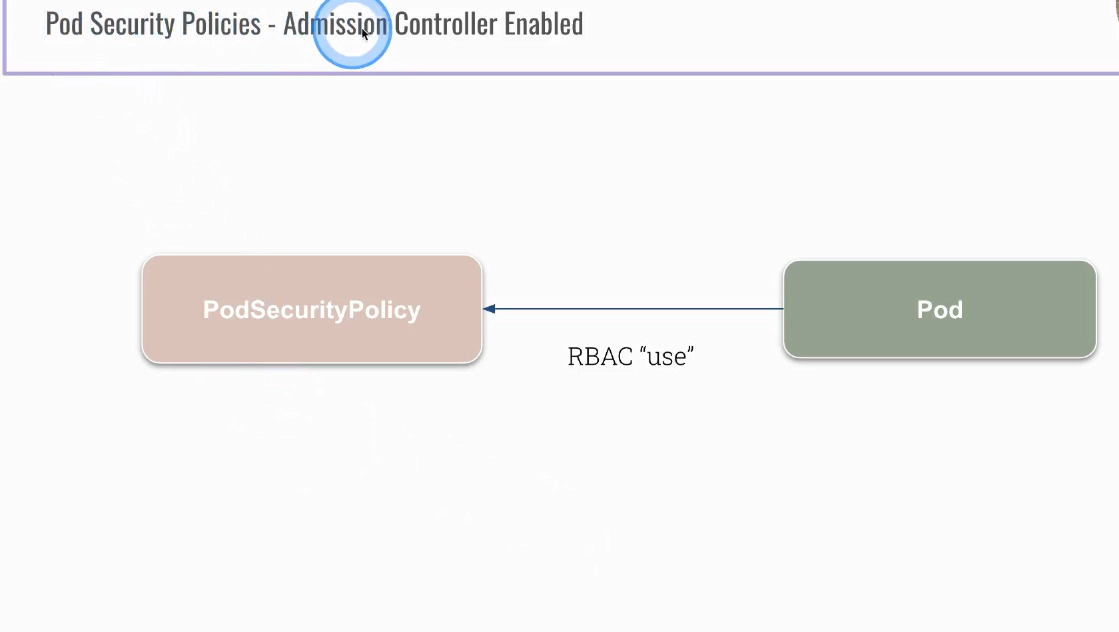I have been in DevOps related jobs for past 6 years dealing mainly with Kubernetes in AWS and on-premise as well. I spent quite a lot …
 :date_long | 6 min Read
:date_long | 6 min ReadCKS OS Level Security Domains
Define privilege and access control for Pod/Container
- userID and GroupID
- run privileged or unprivileged
- Linux Capabilities


Run a simple container and check user and group
root@scw-k8s:~# k run pod --image=busybox --command -oyaml --dry-run=client -- sh -c 'sleep 1d' > bb.yaml
root@scw-k8s:~# k create -f bb.yaml
Now let’s try to setup a security context at a pod level
Edit container recipt first
root@scw-k8s:~# cat bb.yaml
apiVersion: v1
kind: Pod
metadata:
creationTimestamp: null
labels:
run: pod
name: pod
spec:
securityContext:
runAsUser: 1000 # <<< notice
runAsGroup: 3000 # <<< notice
containers:
- command:
- sh
- -c
- sleep 1d
image: busybox
name: pod
resources: {}
dnsPolicy: ClusterFirst
restartPolicy: Always
status: {}
Once pod is created you do not have permissions to create a file in /root directory :)
root@scw-k8s:~# k exec -it pod -- sh
/ $ id
uid=1000 gid=3000
/ $ touch test
touch: test: Permission denied
/ $ touch /tmp/sss.txt
/ $ ls -l /tmp/sss.txt
-rw-r--r-- 1 1000 3000 0 May 30 18:50 /tmp/sss.txt
/ $
Run pod with a flag runAsNonRoot: true
Hmm and YOU will see that it actually runs! Why???
Because we have specified a securityContext at the pod level with values 1000 for user and 3000 for a group previously!
root@scw-k8s:~# cat bb.yaml
apiVersion: v1
kind: Pod
metadata:
creationTimestamp: null
labels:
run: pod
name: pod
spec:
securityContext:
runAsUser: 1000
runAsGroup: 3000
containers:
- command:
- sh
- -c
- sleep 1d
image: busybox
name: pod
resources: {}
securityContext:
runAsNonRoot: true
dnsPolicy: ClusterFirst
restartPolicy: Always
status: {}
Let’s try to comment out the first securityContext section level and see what happens
root@scw-k8s:~# cat bb.yaml
apiVersion: v1
kind: Pod
metadata:
creationTimestamp: null
labels:
run: pod
name: pod
spec:
# securityContext:
# runAsUser: 1000
# runAsGroup: 3000
containers:
- command:
- sh
- -c
- sleep 1d
image: busybox
name: pod
resources: {}
securityContext:
runAsNonRoot: true
dnsPolicy: ClusterFirst
restartPolicy: Always
status: {}
And check the actuall error
root@scw-k8s:~# k get pods
NAME READY STATUS RESTARTS AGE
gvisor 0/1 ContainerStatusUnknown 1 12d
pod 0/1 CreateContainerConfigError 0 5s
root@scw-k8s:~# k describe pod pod
Name: pod
Namespace: default
Priority: 0
Node: scw-k8s/10.18.164.57
...
...
Warning Failed 4s (x4 over 37s) kubelet Error: container has runAsNonRoot and image will run as root (pod: "pod_default(3f4f06af-ff78-48eb-89cb-08c3c511d9c1)", container: pod)
Normal Pulled 4s kubelet Successfully pulled image "busybox" in 1.004495509s
r
Privileged Container
- by default Docker containers run unprivileged
- it is possible to run privileged
- access all devices
- run docker daemon inside container (
docker run --privileged)
- what it means when running privileged??
- well container user 0 (root) maps directly to host user 0 (root)
root@scw-k8s:~# cat bb.yaml
apiVersion: v1
kind: Pod
metadata:
creationTimestamp: null
labels:
run: pod
name: pod
spec:
# securityContext:
# runAsUser: 1000
# runAsGroup: 3000
containers:
- command:
- sh
- -c
- sleep 1d
image: busybox
name: pod
resources: {}
securityContext:
# runAsNonRoot: true
privileged: true
dnsPolicy: ClusterFirst
restartPolicy: Always
status: {}
Now, we were able to run sysctl command inside a container (very dangerous!!!)
/ # sysctl kernel.hostname=attacker
kernel.hostname = attacker
PrivilegeEscalation allowPrivilegeEscalation
- by default - it is enabled in Kubernetes

root@scw-k8s:~# cat bb.yaml
apiVersion: v1
kind: Pod
metadata:
creationTimestamp: null
labels:
run: pod
name: pod
spec:
# securityContext:
# runAsUser: 1000
# runAsGroup: 3000
containers:
- command:
- sh
- -c
- sleep 1d
image: busybox
name: pod
resources: {}
securityContext:
# runAsNonRoot: true
# privileged: true
allowPrivilegeEscalation: false
dnsPolicy: ClusterFirst
restartPolicy: Always
status: {}
Let’s check it out
root@scw-k8s:~# k exec -it pod -- sh
/ # cat /proc/1/status
Name: sleep
Umask: 0022
State: S (sleeping)
Tgid: 1
...
...
...
NoNewPrivs: 1 # <<< notice this setting
Seccomp: 0
voluntary_ctxt_switches: 28
nonvoluntary_ctxt_switches: 288
Pod Security Policies
- cluster level resource
- created by Kubenretes cluster administrator
- it is an admission controller and has to be allowed!!!




Setup kube-apiserver first, since PodSecurityPolicy is an adminssion controller
root@scw-k8s:~# cat /etc/kubernetes/manifests/kube-apiserver.yaml | grep admiss -B10 -A3
name: kube-apiserver
namespace: kube-system
spec:
containers:
- command:
- kube-apiserver
- --advertise-address=10.18.164.57
- --allow-privileged=true
- --authorization-mode=Node,RBAC
- --client-ca-file=/etc/kubernetes/pki/ca.crt
- --enable-admission-plugins=NodeRestriction,PodSecurityPolicy # <<< --- add this text behind comma!
- --enable-bootstrap-token-auth=true
- --etcd-cafile=/etc/kubernetes/pki/etcd/ca.crt
- --etcd-certfile=/etc/kubernetes/pki/apiserver-etcd-client.crt
Create your very first pod security policy
root@scw-k8s:~# cat psp.yaml
apiVersion: policy/v1beta1
kind: PodSecurityPolicy
metadata:
name: cks-psp
spec:
privileged: false # Don't allow privileged pods!
# The rest fills in some required fields.
seLinux:
rule: RunAsAny
supplementalGroups:
rule: RunAsAny
runAsUser:
rule: RunAsAny
fsGroup:
rule: RunAsAny
volumes:
- '*'
Now, you will not be able to create pretty much anything since default serviceaccount does not have any permissions to use podsecuritypolicies k8s objects at all.
k create role psp --verb=use --resource=podsecuritypolicies
k create rolebinding psp-rb --role psp --serviceaccount=default:default
How, about creating a deployment?
# It is gonna work now :)
root@scw-k8s:~# k create deployment jano --image=nginx:alpine
root@scw-k8s:~# k get deploy
NAME READY UP-TO-DATE AVAILABLE AGE
jano 1/1 1 1 11m
The following deployment is going to fail since we want to use privileged: true option. This option is specifically disabled by podsecuritypolicies we created a while ago.
root@scw-k8s:~# k create deployment cks-psp \
--image=nginx:alpine --replicas=3 \
-oyaml --dry-run=client \
| sed -E 's/^(\s+- image.*)$/\1 \n securityContext:\n privileged: true/' | k create -f -
deployment.apps/cks-psp created
root@scw-k8s:~# k get events | grep cks-psp
5s Warning FailedCreate replicaset/cks-psp-79fc878f85 Error creating: pods "cks-psp-79fc878f85-" is forbidden: PodSecurityPolicy: unable to admit pod: [spec.containers[0].securityContext.privileged: Invalid value: true: Privileged containers are not allowed]
46s Normal ScalingReplicaSet deployment/cks-psp Scaled up replica set cks-psp-79fc878f85 to 3
Let’s do a bit more exercise and try to comply with our podsecuritypolicies.
root@scw-k8s:~# k create deployment cks-psp-will-work --image=nginx:alpine --replicas=3 -oyaml --dry-run=client | sed -E 's/^(\s+- image.*)$/\1 \n securityContext:\n privileged: false/' | k create -f -
deployment.apps/cks-psp-will-work created
root@scw-k8s:~# k get deploy
NAME READY UP-TO-DATE AVAILABLE AGE
cks-psp 0/3 0 0 2m46s
cks-psp-will-work 3/3 3 3 43s
Create a privileged pod
# is CKS simulator
k run prime --image=nginx:alpine --privileged=true --command -o yaml --dry-run=client -- sh -c 'apk add iptables && sleep 1d' | k create -f -
pod/prime created
Disable allowPrivilegeEscalation
controlplane $ k get deployments.apps logger -oyaml
apiVersion: apps/v1
kind: Deployment
metadata:
annotations:
deployment.kubernetes.io/revision: "2"
creationTimestamp: "2022-06-03T09:26:23Z"
generation: 2
labels:
app: logger
name: logger
namespace: default
resourceVersion: "1580"
uid: d46deaf9-c544-4062-8d84-becbfa2ad4ba
spec:
progressDeadlineSeconds: 600
replicas: 3
revisionHistoryLimit: 10
selector:
matchLabels:
app: logger
strategy:
rollingUpdate:
maxSurge: 25%
maxUnavailable: 25%
type: RollingUpdate
template:
metadata:
creationTimestamp: null
labels:
app: logger
spec:
containers:
- command:
- sh
- -c
- while true; do cat /proc/1/status | grep NoNewPrivs; sleep 1; done
image: bash:5.0.18-alpine3.14
imagePullPolicy: IfNotPresent
name: httpd
resources: {}
securityContext:
allowPrivilegeEscalation: false
terminationMessagePath: /dev/termination-log
terminationMessagePolicy: File
dnsPolicy: ClusterFirst
restartPolicy: Always
schedulerName: default-scheduler
securityContext: {}
terminationGracePeriodSeconds: 0
status:
availableReplicas: 3
...
replicas: 3
updatedReplicas: 3